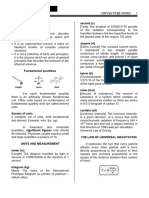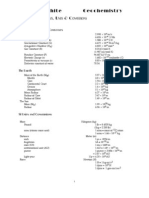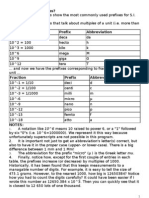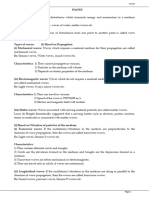Module 1 - Introduction
Uploaded by
raiModule 1 - Introduction
Uploaded by
rai1|FUNDAMENTAL CONCEPTS
MODULE 1 – FUNDAMENTAL CONCEPTS
Description:
Module 1 provides a discussion of fundamental concepts of Engineering Mechanics, system of
Units, conversion Factors and SI Prefixes
Objectives:
After completing the module, the students are expected to:
1. Understand the fundamental concepts of Engineering Mechanics
2. Become familiar with the System of Units, Conversion Factors and SI Prefixes
Duration:
Contents:
Fundamental Concepts of Engineering Mechanics:
1. Three divisions Mechanics
2. Two divisions of Mechanics of Rigid Bodies
3. Six fundamental principles of Mechanics based on experiments evidences
4. System of Units
5. SI Prefixes
6. Conversion of Units
Discussion:
Mechanics is a branch of Physical Science which describes and predicts the conditions of rest or
motion of bodies under the action of forces. It deals with Newton’s Law of Motion. It serves as a bridge
between theory and application.
Three Divisions of Mechanics
❖ Mechanics of Rigid Bodies
❖ Mechanics of Deformable Bodies
❖ Mechanics of Fluids
Two Divisions of Mechanics of Rigid Bodies
❖ Statics - dealing with bodies at rest
❖ Dynamics - dealing with bodies in motion
STATICS OF RIGID BODIES
Compiled By: JUANITA CARMELITA R. ZOLETA
Reviewed By: ROWEL D. WAJE
2|FUNDAMENTAL CONCEPTS
Six fundamental principles of Mechanics based on experiments evidences:
1. The Parallelogram Law for the Addition of Forces
This states that two forces acting on a particle maybe F2
replaced by a single force, called the resultant, obtained by
drawing the diagonal of the parallelogram which has sides equal R F1
F1
to the given forces.
F2
2. The Principle of Transmissibility
This states that the conditions of equilibrium or of motion of a rigid body will remain
unchanged if a force acting at a given point of the rigid body is replaced by a force of the same
magnitude and same direction, but acting at a different point, provided that the two forces have the
same line of action.
3. Newton’s First Law of Motion
If the resultant forces acting on a particle are zero, the particle will remain at rest (if
originally at rest) or will move with constant speed in a straight line (if originally in motion).
4. Newton’s Second Law of Motion
If the resultant force acting on a particle is not zero, the particle will have acceleration
proportional to the magnitude of the resultant and in the direction of this resultant force. F = ma.
5. Newton’s Third Law of Motion
The forces of action and reaction between bodies in contact have the same magnitude, same
line of action and opposite sense.
6. Newton’s Law of Gravitation
This states that two particles of mass M and m are mutually attracted with equal and
opposite forces F and F’ of magnitude F given by the formula
GMm
F=
r2
Where:
r
r = distance between two particles
M F F’ m G = universal constant called the constant of
gravitation
STATICS OF RIGID BODIES
−11 m3
Compiled By: JUANITA CARMELITA R. ZOLETA G = 6.67 x10
Reviewed By: ROWEL D. WAJE kg − s 2
3|FUNDAMENTAL CONCEPTS
System of Units:
International System of Units (SI units)
a. Length
The meter had its origin in the metric system. By international agreement, the standard
meter had been defined as the distance between two fine lines on a bar of platinum - iridium alloy.
The 1960 conference redefined the meter as 1, 650, 763. 73 wavelengths of the reddish - orange
light emitted by the isotope krypton - 86. The meter was again redefined in 1983 as the length of
the path traveled by light in vacuum during a time interval of 1 / 299, 792, 458 of a second.
b. Mass
When the metric system was created, the kilogram was defined as the mass of 1 cubic
decimeter of pure water at the temperature of its maximum density (4.0˚C / 39.2˚F). A solid
cylinder of platinum was carefully made to match this quantity of water under the specified
conditions. Later it was discovered that a quantity of water as pure or as stable as required could
not be provided. Therefore, the primary standard of mass became the platinum cylinder, which
was replaced in 1889 by a platinum - iridium cylinder of similar mass. Today this cylinder still
serves as the international kilogram, and the kilogram in SI is defined as a quantity of mass of the
international prototype of the kilogram.
c. Time
For centuries, time has been universally measured in terms of the rotation of the earth. The
second, the basic unit of time, was defined as 1 / 86, 400 of a mean solar day (see Day) or one
complete rotation of the earth on its axis. Scientists discovered, however, that the rotation of the
earth was not constant enough to serve as the basis of the time standard. As a result, the second was
redefined in 1967 in terms of the resonant frequency of the cesium atom - that is, the frequency at
which this atom absorbs energy, or 9, 192, 631, 770 hertz (cycles per second).
STATICS OF RIGID BODIES
Compiled By: JUANITA CARMELITA R. ZOLETA
Reviewed By: ROWEL D. WAJE
4|FUNDAMENTAL CONCEPTS
SI Prefixes
Multiplication Factor Prefix Symbol
1,000,000,000,000,000,000 = 1 x 10 18 Exa E
1,000,000,000,000,000 = 1 x 1015 Peta P
1,000,000,000,000 = 1 x 1012 Tera T
1,000,000,000 = 1 x 109 Giga G
1,000,000 = 1 x 106 Mega M
1,000 = 1 x 103 Kilo K
100 = 1 x 102 hecto h
10 deka da
0.10 = 1 x 10 -1 deci d
0.01 = 1 x 10 -2 centi c
0.001 = 1 x 10 -3 milli m
0.000001 = 1 x 10 -6 micro μ
0.000000001 = 1 x 10 -9 nano η
0.000000000001 = 1 x10 -12 pico р
Conversion of Units:
❖ Length 1 foot = 12 inches
1 mile = 5280 feet
1 inch = 2.54 centimeters
1 foot = 0.3048 meter
1 meter = 3.281 feet = 39.37 inches
❖ Time 1 day = 24 hours
1 hour = 60 minutes
1 minute = 60 seconds
❖ Mass 1 slug = 14.59 kilograms
❖ Force 1 pound = 4.448 Newton
❖ Angle 2πradians = 360 degrees
STATICS OF RIGID BODIES
Compiled By: JUANITA CARMELITA R. ZOLETA
Reviewed By: ROWEL D. WAJE
5|FUNDAMENTAL CONCEPTS
Examples:
9 Mg = 9000 kg
10 GPa = 10 x 103 MPa
12 μm = 12 x 10- 9 km
23 ηg = 23 x 10- 6 mg
1 day = 86, 400 sec
1 mile = 1.6098 km
STATICS OF RIGID BODIES
Compiled By: JUANITA CARMELITA R. ZOLETA
Reviewed By: ROWEL D. WAJE
6|FUNDAMENTAL CONCEPTS
Principal SI units used in Mechanics
Quantity Unit Symbol Formula
m
Acceleration Meter per second squared
s2
Angle radian rad
rad
Angular acceleration Radian per second squared
s2
rad
Angular velocity Radian per second
s
Area Square meter m2
kg
Density Kilogram per cubic meter
m3
Energy joule J N-m
kg − m
Force Newton N
s2
Frequency Hertz Hz s -1
Length meter m
Mass kilogram kg
Moment of a force Newton - meter N-m
Power Watt W J/s
N
Pressure Pascal Pa
m2
N
Stress Pascal Pa
m2
Time Second s
m
Velocity meter per second
s
Volume cubic meter m3
Work Joule J N-m
STATICS OF RIGID BODIES
Compiled By: JUANITA CARMELITA R. ZOLETA
Reviewed By: ROWEL D. WAJE
7|FUNDAMENTAL CONCEPTS
References:
1. Vector Mechanics for Engineers 10 th Edition, Beer, F.P., Johnston, E.R.Jr, Mazurek, D.F.,
Cornwell, P.J.2013
2. Engineering Mechanics Statics 13th Edition, Hibbeler, R.C.,2013
3. Engineering Mechanics Statics 14th Edition, Hibbeler, R.C.,2016
STATICS OF RIGID BODIES
Compiled By: JUANITA CARMELITA R. ZOLETA
Reviewed By: ROWEL D. WAJE
You might also like
- Name: Roll No: Class: XI Date: 24-04-2020 Subject: Physics Topic: Unit-1, Chapter-2 Units and Measurements 2020-21No ratings yetName: Roll No: Class: XI Date: 24-04-2020 Subject: Physics Topic: Unit-1, Chapter-2 Units and Measurements 2020-213 pages
- 10th STD Science Slow Learners Material-1No ratings yet10th STD Science Slow Learners Material-140 pages
- 04 - Dimensions Units and Error AnalysisNo ratings yet04 - Dimensions Units and Error Analysis17 pages
- Module 6 - Equilibrium of Concurrent Force System in Space100% (2)Module 6 - Equilibrium of Concurrent Force System in Space4 pages
- Module 5 - Resultant of Concurrent Force System in SpaceNo ratings yetModule 5 - Resultant of Concurrent Force System in Space9 pages
- Module 2 - Force and Their CharacteristicsNo ratings yetModule 2 - Force and Their Characteristics5 pages
- ME 212-Module 1-Field of Engineering ManagementNo ratings yetME 212-Module 1-Field of Engineering Management4 pages
- Rotational Motion _ Practice Sheet (Advanced)No ratings yetRotational Motion _ Practice Sheet (Advanced)5 pages
- The Work Behind One Half of The 2021 Physics Nobel Prize: Rama GovindarajanNo ratings yetThe Work Behind One Half of The 2021 Physics Nobel Prize: Rama Govindarajan5 pages
- Question Bank-structure of Atom-grade 11No ratings yetQuestion Bank-structure of Atom-grade 1116 pages
- Di Spirito Et Al 2022 Bubble Rupture and Bursting Velocity of Complex FluidsNo ratings yetDi Spirito Et Al 2022 Bubble Rupture and Bursting Velocity of Complex Fluids8 pages
- KSEEB 2nd PUC Physics Previous Year Question Paper March 2015No ratings yetKSEEB 2nd PUC Physics Previous Year Question Paper March 20153 pages
- HO3-1 - Week2 - Introduction To Quantum Mechanics - Video - SlideNo ratings yetHO3-1 - Week2 - Introduction To Quantum Mechanics - Video - Slide54 pages
- Instant ebooks textbook (Ebook) Basic Ideas and Concepts in Nuclear Physics: An Introductory Approach by Kris L.G. Heyde ISBN 9780750309806, 9781420054941, 0750309806, 1420054945 download all chaptersNo ratings yetInstant ebooks textbook (Ebook) Basic Ideas and Concepts in Nuclear Physics: An Introductory Approach by Kris L.G. Heyde ISBN 9780750309806, 9781420054941, 0750309806, 1420054945 download all chapters72 pages
- (Ebooks PDF) Download Handbook of Frozen Food Processing and Packaging Second Edition Da-Wen Sun Full Chapters100% (2)(Ebooks PDF) Download Handbook of Frozen Food Processing and Packaging Second Edition Da-Wen Sun Full Chapters64 pages
- Handbook of Colloid and Interface Science Basic Principles of Dispersions 1st Edition Tharwat F. TadrosNo ratings yetHandbook of Colloid and Interface Science Basic Principles of Dispersions 1st Edition Tharwat F. Tadros69 pages
- Matter in Our Surroundings Just Padhle MarathonNo ratings yetMatter in Our Surroundings Just Padhle Marathon76 pages
- JEE_Main-2025_Ph-1!23!01-2025_FN Physics Memory Based QuestionsNo ratings yetJEE_Main-2025_Ph-1!23!01-2025_FN Physics Memory Based Questions6 pages
- CAPE Physics Workshop Workbook 2021 - Unit 1No ratings yetCAPE Physics Workshop Workbook 2021 - Unit 131 pages
- Physics: Laminated QuickStudy Reference GuideFrom EverandPhysics: Laminated QuickStudy Reference Guide
- Name: Roll No: Class: XI Date: 24-04-2020 Subject: Physics Topic: Unit-1, Chapter-2 Units and Measurements 2020-21Name: Roll No: Class: XI Date: 24-04-2020 Subject: Physics Topic: Unit-1, Chapter-2 Units and Measurements 2020-21
- Module 6 - Equilibrium of Concurrent Force System in SpaceModule 6 - Equilibrium of Concurrent Force System in Space
- Module 5 - Resultant of Concurrent Force System in SpaceModule 5 - Resultant of Concurrent Force System in Space
- The Work Behind One Half of The 2021 Physics Nobel Prize: Rama GovindarajanThe Work Behind One Half of The 2021 Physics Nobel Prize: Rama Govindarajan
- Di Spirito Et Al 2022 Bubble Rupture and Bursting Velocity of Complex FluidsDi Spirito Et Al 2022 Bubble Rupture and Bursting Velocity of Complex Fluids
- KSEEB 2nd PUC Physics Previous Year Question Paper March 2015KSEEB 2nd PUC Physics Previous Year Question Paper March 2015
- HO3-1 - Week2 - Introduction To Quantum Mechanics - Video - SlideHO3-1 - Week2 - Introduction To Quantum Mechanics - Video - Slide
- Instant ebooks textbook (Ebook) Basic Ideas and Concepts in Nuclear Physics: An Introductory Approach by Kris L.G. Heyde ISBN 9780750309806, 9781420054941, 0750309806, 1420054945 download all chaptersInstant ebooks textbook (Ebook) Basic Ideas and Concepts in Nuclear Physics: An Introductory Approach by Kris L.G. Heyde ISBN 9780750309806, 9781420054941, 0750309806, 1420054945 download all chapters
- (Ebooks PDF) Download Handbook of Frozen Food Processing and Packaging Second Edition Da-Wen Sun Full Chapters(Ebooks PDF) Download Handbook of Frozen Food Processing and Packaging Second Edition Da-Wen Sun Full Chapters
- Handbook of Colloid and Interface Science Basic Principles of Dispersions 1st Edition Tharwat F. TadrosHandbook of Colloid and Interface Science Basic Principles of Dispersions 1st Edition Tharwat F. Tadros
- JEE_Main-2025_Ph-1!23!01-2025_FN Physics Memory Based QuestionsJEE_Main-2025_Ph-1!23!01-2025_FN Physics Memory Based Questions
































































































